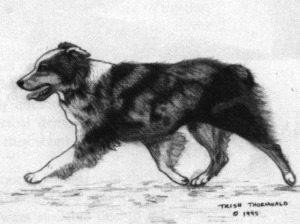The Australian Shepherd may have to trail stock for many miles and at any given moment be able to display great bursts of speed to outrun and turn a maverick. He often employs many forms of gait during any given day. His ability to maneuver quickly at full speed is referred to as agility. The dog that is able to cover the greatest amount of steps without sacrificing agility is ideal. In other words, the moderately angulated, balanced individual is the most functional and therefore the most desirable.
The gait most often chosen to assess correct gait is the trot. This is a symmetrical gait in which the legs of either side repeat the actions of the other side, but they do so a half a stride later. The trot is a gait of medium speed in which the dog is supported by alternating diagonal pairs of limbs. The forequarter legs are off the ground only a split second longer than the legs of the hindquarter to allow the front feet to clear the ground in advance of the placement of the hind legs on the same side. When the front foot leaves the ground, the hind foot takes or “fills” its place.
 When the Australian Shepherd shifts from the walk into an easy, slow trot, the gait is called “collected.” In the “extended” trot, the legs reach out to increase stride length and speed. (The length of stride is measured from the place where one paw leaves the ground to the place where the same paw again strikes the ground.) When a period of suspension occurs between the support phases and propulsion, the gait is referred to as a “flying” or “suspended” trot.
When the Australian Shepherd shifts from the walk into an easy, slow trot, the gait is called “collected.” In the “extended” trot, the legs reach out to increase stride length and speed. (The length of stride is measured from the place where one paw leaves the ground to the place where the same paw again strikes the ground.) When a period of suspension occurs between the support phases and propulsion, the gait is referred to as a “flying” or “suspended” trot.
It can take many years of observation to apply knowledge of gait. The interplay of strengths and weaknesses between fore and hind assemblies is more clearly revealed in the trot than in any other gait. By viewing the Australian Shepherd at a trot from the side you can see the interaction of the forequarters with the hindquarters. The Aussie’s gait suggests endurance. There is an effortless quality in the stride, which is deliberate without wasting energy. The most effective movement does not always stand out and attract attention. However, its quality is never mistaken because all parts harmonize without disrupting the interworking of other parts. When viewed from the side the dog’s topline should be strong and appear level between the shoulders and the loin. When the dog is trotting there should be no bobbing, as the withers should remain level in motion. Any up-and-down movement wastes energy and indicates another structural inefficiency.
Sometimes while in the working gait, the Australian Shepherd may drop his head slightly. When alert or focusing his attention on something, however, he can lift his head while in motion.
Actual body length determines foot placement, which is governed by angulation. The Aussie is slightly longer than he is tall. Balance and symmetry are the first and foremost requirements in a working breed. This is influenced by correct static conformation, but is measured by the yardstick of performance. Correct shoulder angulation that allows adequate reach but that lacks the corresponding angulation of the driving hindquarters is of little value. This kind of dog cannot “fill” his fore tracks and ends up wasting energy. On the other hand, an Aussie with well-angled hindquarters and insufficiently angulated forequarters overdrives the front assembly by forcing the front feet and legs to get out of the way of the back ones, causing faults such as dwelling and crabbing.
Condensed from All About Aussies, copyright © 2009 by Jeanne-Joy Hartnagle-Taylor.

[…] kicked into action. They pranced down the middle of Multnomah Village, showing off their beautiful Aussie gait and glancing at the hoardes of admirers sitting on the side of the street. We heard people tell […]
Hello Sir
Thanks for sharing the great information. I read this blog and must say the information that you shared in this blog is really very useful. Please post more blog related to ” Australian dog lovers”. It would be really helpful for those people who want to share their best memories with pets.
Thank You.